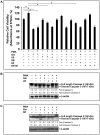[6]-Gingerol induces caspase-dependent apoptosis and prevents PMA-induced proliferation in colon cancer cells by inhibiting MAPK/AP-1 signaling
- PMID: 25157570
- PMCID: PMC4144808
- DOI: 10.1371/journal.pone.0104401
[6]-Gingerol induces caspase-dependent apoptosis and prevents PMA-induced proliferation in colon cancer cells by inhibiting MAPK/AP-1 signaling
Abstract
We report mechanism-based evidence for the anticancer and chemopreventive efficacy of [6]-gingerol, the major active principle of the medicinal plant, Ginger (Zingiber officinale), in colon cancer cells. The compound was evaluated in two human colon cancer cell lines for its cytotoxic effect and the most sensitive cell line, SW-480, was selected for the mechanistic evaluation of its anticancer and chemopreventive efficacy. The non-toxic nature of [6]-gingerol was confirmed by viability assays on rapidly dividing normal mouse colon cells. [6]-gingerol inhibited cell proliferation and induced apoptosis as evidenced by externalization of phosphatidyl serine in SW-480, while the normal colon cells were unaffected. Sensitivity to [6]-gingerol in SW-480 cells was associated with activation of caspases 8, 9, 3 &7 and cleavage of PARP, which attests induction of apoptotic cell death. Mechanistically, [6]-gingerol down-regulated Phorbol Myristate Acetate (PMA) induced phosphorylation of ERK1/2 and JNK MAP kinases and activation of AP-1 transcription factor, but had only little effects on phosphorylation of p38 MAP kinase and activation of NF-kappa B. Additionally, it complemented the inhibitors of either ERK1/2 or JNK MAP kinase in bringing down the PMA-induced cell proliferation in SW-480 cells. We report the inhibition of ERK1/2/JNK/AP-1 pathway as a possible mechanism behind the anticancer as well as chemopreventive efficacy of [6]-gingerol against colon cancer.
Conflict of interest statement
Figures






References
-
- Magalhaes B, Peleteiro B, Lunet N (2012) Dietary patterns and colorectal cancer: systematic review and meta-analysis. Eur J Cancer Prev 21: 15–23. - PubMed
-
- Mayer RJ (2009) Targeted therapy for advanced colorectal cancer–more is not always better. N Engl J Med 360: 623–625. - PubMed
-
- Krell J, Stebbing J (2012) Ginger: the root of cancer therapy? Lancet Oncol 13: 235–236. - PubMed
-
- Surh YJ, Lee E, Lee JM (1998) Chemoprotective properties of some pungent ingredients present in red pepper and ginger. Mutat Res 402: 259–267. - PubMed
MeSH terms
Substances
LinkOut - more resources
Full Text Sources
Other Literature Sources
Research Materials
Miscellaneous

